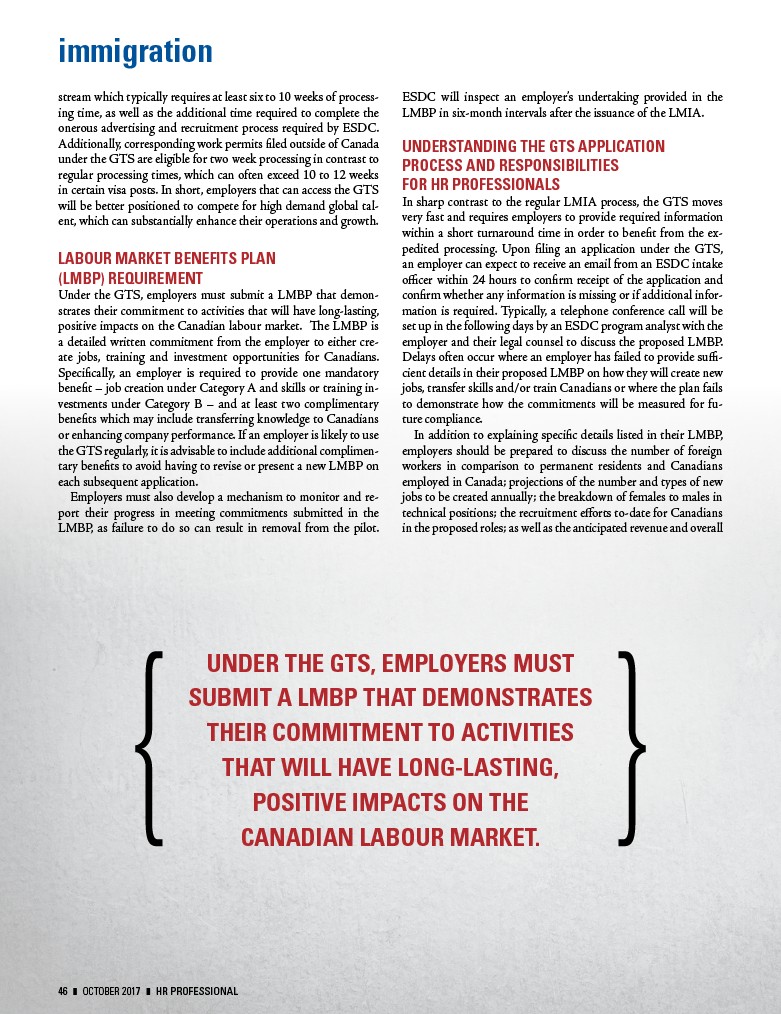
stream which typically requires at least six to 10 weeks of process-ing
time, as well as the additional time required to complete the
onerous advertising and recruitment process required by ESDC.
Additionally, corresponding work permits filed outside of Canada
under the GTS are eligible for two week processing in contrast to
regular processing times, which can often exceed 10 to 12 weeks
in certain visa posts. In short, employers that can access the GTS
will be better positioned to compete for high demand global tal-ent,
which can substantially enhance their operations and growth.
LABOUR MARKET BENEFITS PLAN
(LMBP) REQUIREMENT
Under the GTS, employers must submit a LMBP that demon-strates
their commitment to activities that will have long-lasting,
positive impacts on the Canadian labour market. The LMBP is
a detailed written commitment from the employer to either cre-ate
jobs, training and investment opportunities for Canadians.
Specifically, an employer is required to provide one mandatory
benefit – job creation under Category A and skills or training in-vestments
under Category B – and at least two complimentary
benefits which may include transferring knowledge to Canadians
or enhancing company performance. If an employer is likely to use
the GTS regularly, it is advisable to include additional complimen-tary
benefits to avoid having to revise or present a new LMBP on
each subsequent application.
Employers must also develop a mechanism to monitor and re-port
their progress in meeting commitments submitted in the
LMBP, as failure to do so can result in removal from the pilot.
ESDC will inspect an employer’s undertaking provided in the
LMBP in six-month intervals after the issuance of the LMIA.
UNDERSTANDING THE GTS APPLICATION
PROCESS AND RESPONSIBILITIES
FOR HR PROFESSIONALS
In sharp contrast to the regular LMIA process, the GTS moves
very fast and requires employers to provide required information
within a short turnaround time in order to benefit from the ex-pedited
processing. Upon filing an application under the GTS,
an employer can expect to receive an email from an ESDC intake
officer within 24 hours to confirm receipt of the application and
confirm whether any information is missing or if additional infor-mation
is required. Typically, a telephone conference call will be
set up in the following days by an ESDC program analyst with the
employer and their legal counsel to discuss the proposed LMBP.
Delays often occur where an employer has failed to provide suffi-cient
details in their proposed LMBP on how they will create new
jobs, transfer skills and/or train Canadians or where the plan fails
to demonstrate how the commitments will be measured for fu-ture
compliance.
In addition to explaining specific details listed in their LMBP,
employers should be prepared to discuss the number of foreign
workers in comparison to permanent residents and Canadians
employed in Canada; projections of the number and types of new
jobs to be created annually; the breakdown of females to males in
technical positions; the recruitment efforts to-date for Canadians
in the proposed roles; as well as the anticipated revenue and overall
immigration
UNDER THE GTS, EMPLOYERS MUST
SUBMIT A LMBP THAT DEMONSTRATES
THEIR COMMITMENT TO ACTIVITIES
THAT WILL HAVE LONG-LASTING,
POSITIVE IMPACTS ON THE
CANADIAN LABOUR MARKET.
46 ❚ OCTOBER 2017 ❚ HR PROFESSIONAL